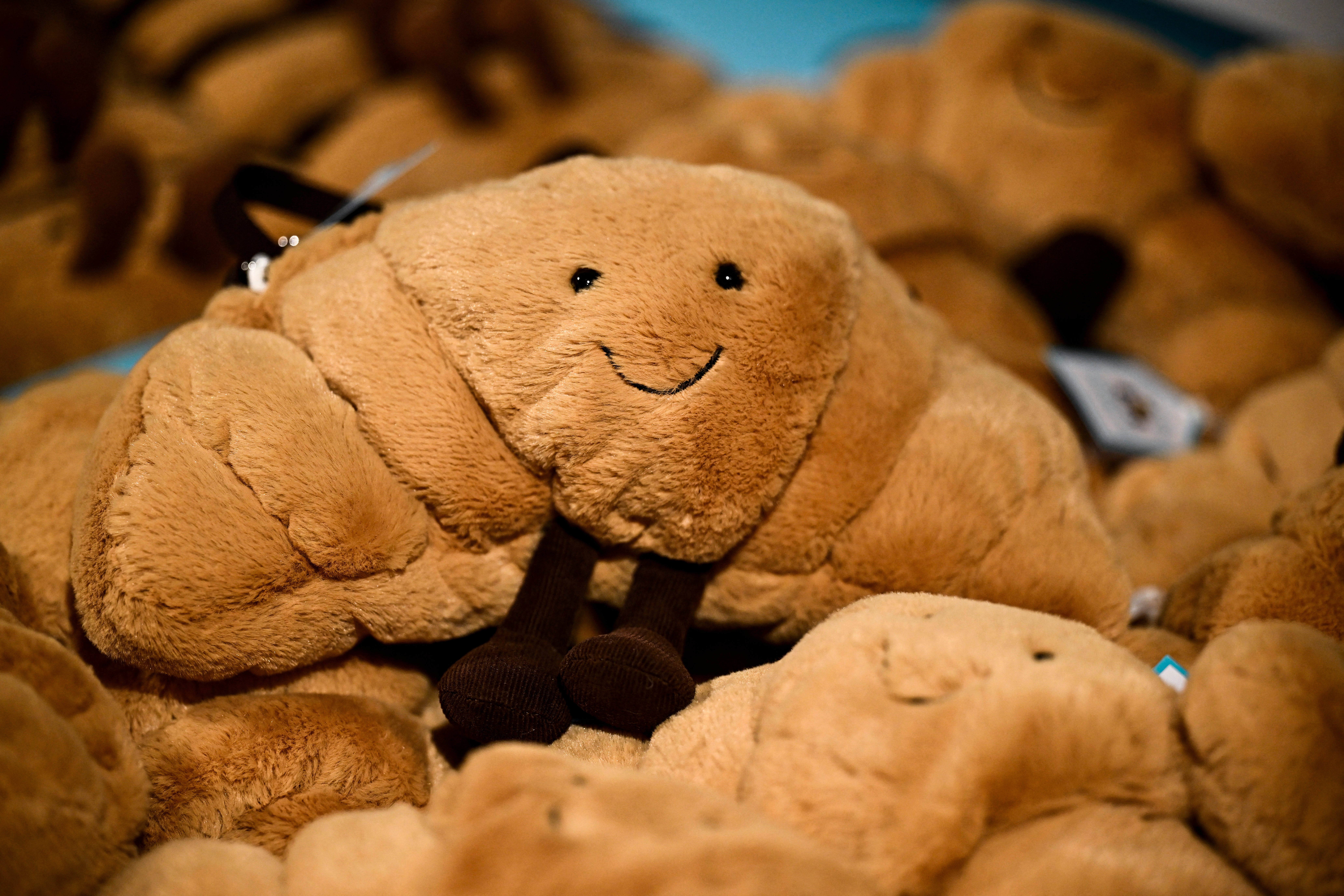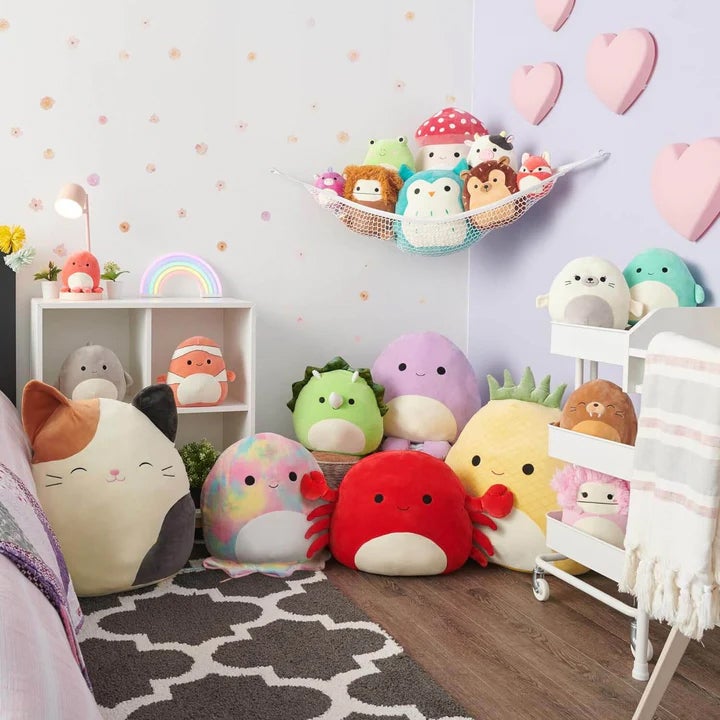
When 23-year-old Aïcha travelled from London to New York last year, it wasn’t for a holiday. She was on a mission to buy a rare Squishmallow, a type of cuddly toy that’s a hybrid between a pillow and a stuffed animal. She already has 35 of them, her bed at home neatly lined with a pig named Daisy that doubles up as a handbag, a puppy holding a bubble tea, an aquamarine-coloured dolphin, and many, many more.
“I call them my babies,” Aïcha tells me. “They make me feel so safe, they hear me out and they see everything. They’re like my little witnesses in life.” While Squishmallows is her current favourite brand, Aïcha combs through the internet for rare Black Barbies and Bratz dolls, because she never saw herself represented in toys as a child. “My bed is filled with them,” she says. “It’s a piece of me.”
Squishmallows is just one of the cuddly toy companies currently obsessed over by Gen Z. Another popular brand is Jellycat, which transforms household objects or food items – such as a pair of salt and pepper shakers – into a cute, plush form to be squeezed and hugged. These toys aren’t just something kept at home, either: if you look closely at a Gen Z-ers outfit, you may find a pink furry animal affixed to their belt strap.
Across Hollywood, celebrities are endorsing cuddlies, too. Jisoo, a member of the K-pop group Blackpink, is sometimes seen with a Jellycat bunny dangling from her handbag. Kylie Jenner told fans she carries her Jellycat peapod in her handbag all day, while Dua Lipa recently posed in the back of a car cuddling a Squishmallow of the Pokémon character Snorlax.
In the past, a young person would leave behind their old, distressed childhood toys when they flew the nest. And for those who did bring their toy collection to university or into adult life, they would keep it a secret out of pure embarrassment. It seems peculiar, then, that it’s become acceptable to accumulate a gargantuan stuffed toy collection that competes with one owned by a toddler, or alternatively wear them as a fashion statement with pride. And fundamentally, does it mean that Gen Z are scared to grow up?
Before I go any further, I should admit that I have a very close relationship with a stuffed panda from Ikea that I bought last year. I call her Penny. Do I cradle her in my arms as I sleep each night? I couldn’t possibly comment, if only to retain some of my dignity at work. But I will tell you that I find it hard to leave her behind when I go away for a few nights. She’s my most loyal companion. So if this is a problem, I’m very much a part of it.

Currently, the toys-for-adults market is worth £1bn in the UK, while £1 of every £3 currently spent on toys is spent by a “kidult” – an adult consumer interested in entertainment aimed at children – according to toy industry analyst company Circana. Kidult consumers are spending more money in the cuddly toy market, too: 65 per cent of Squishmallow buyers are aged between 18 and 24, and Jellycat US sales rose 41 per cent from the first half of 2023 to the same period in 2024.
For 24-year-old Alanna, who works in finance, her Jellycat collection began the day she was born – that was when she was bought a small, delicate elephant. From there, her collection grew. “When I finished university, my dad decided to give me this enormous Jellycat elephant as a joke, [as it] was the biggest they have,” she says. Alanna’s elephant family isn’t something she hides away or is embarrassed about; her teddies sit proudly on her bed when her friends or boyfriend come over.
More than anything, Alanna thinks her growing toy collection comes from a combination of childhood nostalgia and seeking comfort. “I have quite an intense job and come home at the end of the day feeling quite tired,” she says. “When I’m lying on the sofa or going to sleep, I just like to have something to sort of hold on to and hug. I find it easier to relax – it’s a comfort when we live in a world that’s so hectic.”
Joshua Dale is a professor of cute studies at Chuo University in Tokyo, Japan, and the author of Irresistible: How Cuteness Wired our Brains and Conquered the World. He tells me that cute items, like stuffed toys, are “happiness generators” for adults. From what he’s observed, Gen Z’s appreciation for plushies comes from a desire to alleviate anxiety or worry. “It’s quite hard to just be happy in the moment, when there are so many things happening in the world right now,” says Dale. If you look at something you find cute, though, you might just be perked up.
In the academic world, the very definition of “cute” is based on the idea of baby schema, which is a set of physical features – large eyes, a round face, chubby cheeks – belonging to an infant that triggers a certain response in adults. These are the elements that might cause someone to let out an instantaneous “awwww!” when they see a newborn, for example, or want to care for the baby or hold it. For others, a similar response can be elicited by seeing features that belong to a baby or animal incorporated into a toy’s design. Dale refers to this feeling as an “upwelling”.

“Seeing something cute trips the neural networks in our brain [and makes us] engage in behaviours like empathy or a sense of playfulness,” says Dale. “It works so well that we feel it towards cats and dogs and even objects like Squishmallows.” The blushing, smiley expression given to these toys – even if that toy is just a fuzzy cabbage – can make them even more cherubic. “If you see something that has a smile, it means that thing is willing to engage with us and we want to get closer to it,” he adds.
The texture of these plushie toys adds to the appeal, too. Psychologist Veronica West tells me that this is known as tactile comfort. “Hugging a fluffy croissant or smooshing a smiling cauliflower is an instant serotonin boost,” she says. “It’s like an emotional support animal, minus the vet bills or the risk of it peeing on your carpet. Cuddly toys provide a safe, soft space to decompress.”
This doesn’t indicate that Gen Z is growing up slower, either, or that they suffer from a generational-wide Peter Pan syndrome, says Dale. “The detractors of this phenomenon tend to say that it’s really childish,” he explains, highlighting the difference between “childish” and “childlike”. “Childish behaviour is bad in everyone, even children. But childlike behaviour involves having a sense of curiosity and wonder, and a willingness to learn new things. These are not bad characteristics.”
Really, bringing childlike elements into your daily life as an adult can be extremely fruitful. “I think the definition of being an adult is changing and becoming a little more flexible,” says Dale. “And I think what this movement is about is being able to openly incorporate things we loved as children into our adult lives.”
West agrees that the boom in adult toys is not reflective of a doomed generation scared to grow up, but a generation ageing in a way that is more curious and playful compared to their forebears. “Who says adulthood can’t include joy and softness? In a world that sometimes feels like a horror movie, Gen Z has decided their coping mechanism is cuddling a fluffy pineapple,” she says. “And honestly, they might be onto something.”
As I write this with my Ikea Panda perched in my lap, I couldn’t agree more.







